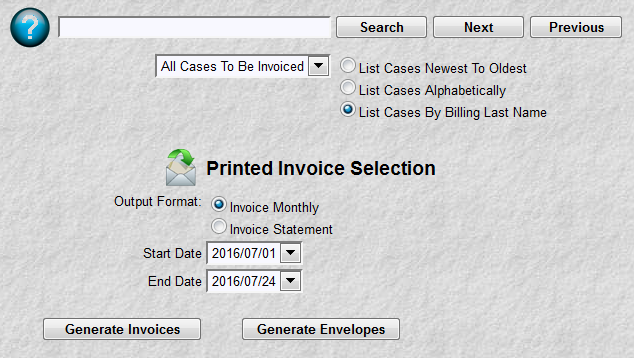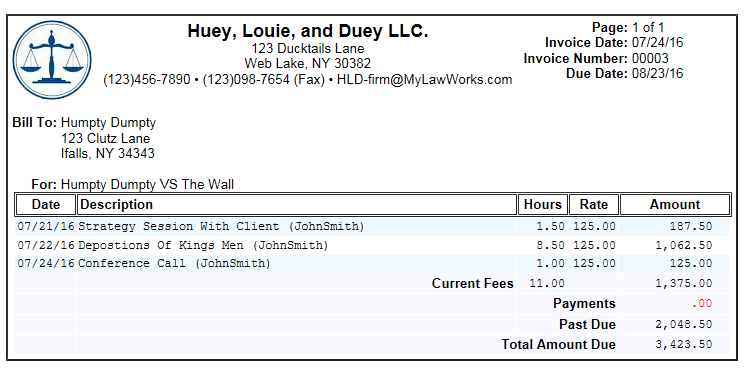

![]() Printed Invoices HELP
Printed Invoices HELP

The purpose of this program is to produce invoice(s) or statement(s) for a chosen date range. You can generate these document(s) for a particular case or all cases. You have 4 groups of data which help you produce the invoice(s) or statement(s).
The 1st data group is the standard MyLawWorks search bar. Here the bar will search the Case Files for a matching key. The standard MyLawWorks search bar is described in the Operations section of the help index.
The 2nd data group is the standard MyLawWorks case selection listbox. Here you can select a particular case or all cases and sort the listbox for easier reading.
The 3rd data group allows you to select a document format of invoice or statement. An invoice format will produce a document with an invoice number, a previous balance, and a list of transactions for a specified date range. A statement format will produce a document with no invoice number, no previous balance and ALL transactions from inception to the specified end date. No start date is required for a statement.
The 4th data group allows you to select date(s) or specify a date range to control the transactions to be listed on the invoice(s) or statement(s).
After entering your data click the "Generate Invoices" button. The invoices will then be generated/listed for your review or printing. The list of invoices or statements will be presented in its own window. When you are finished with this window, click the 'X' (destroy) button at the top right of your browser window.
The "Generate Envelopes" button will create a printable list of clients. Only clients with invoices will be in the list. A standard size envelope will suffice. On most printers, selecting landscape printing, then single feeding the envelopes on the left side of the printer, face down (back of envelope face up) will produce a very nice printed envelope for mailing. You may have to try a few sample prints before learning the nuances of your particular printer. The list of envelopes will be presented in its own window. When you are finished with this window, click the 'X' (destroy) button at the top right of your browser window.
If you see an invoice that needs a correction (missing transaction, incorrect billing rate, etc), click the 'X' (destroy) button at the top right of your browser window, make your corrections (transaction correction, bill rate entry, etc) and generate the invoices again. Or you can use the techniques in the special processing section below.
Upon occasion the invoicing program will find an error that prevents processing. A sample error is pictured below:

In this particular example, after you acknowledge the error (by clicking OK) a listbox of the transaction(s) in error will be presented. The transactions are presented so that you may easily correct the error. A sample of this is pictured below:

Notice the button Generate TSV File ?
 If clicked this button will
display the invoice data in text only format. No graphics will appear. Each data value is separated by a tab
character. A tab character causes the data elements to align in columns. Hence the name TSV or Tab Separated
Values. A TSV file is a common format for importing into other applications, such as a spreadsheet.
If clicked this button will
display the invoice data in text only format. No graphics will appear. Each data value is separated by a tab
character. A tab character causes the data elements to align in columns. Hence the name TSV or Tab Separated
Values. A TSV file is a common format for importing into other applications, such as a spreadsheet.
Some law firms need certain cases in a text only format. This allows them to manipulate the invoice data to a different format. For example, insurance companies require invoice data to be sent in electronically in a certain format.
To save this text only invoice
data to your computer, use your browser's toolbar as pictured here:

Does the text data looked jumbled
or misaligned ? Then take a look at your browser's settings. Do not select the viewing option of word wrap as
picture here: 
The technical specifications of the text file are listed below. Basically there are 3 types of records in the text file. A Header record, with the letter H in column one, which contains the case description, your firm's contact information, and client contact information. A Detail record, with the letter D in column one, which contains information about each charge or credit. A Total Record, with the letter T in column one, which contains any total information about the invoice.
Header Record, column 1 = H
- Case Description
- Firm Name
- Firm Address 1
- Firm Address 2
- Firm Address 3
- Firm Address 4
- Firm Fax Number
- Firm Phone Number
- Firm Email Address
- Invoice Date
- Invoice Number
- Invoice Due Date
- Bill To Name
- Bill To Address 1
- Bill To Address 2
- Bill To Address 3
- Bill To Address 4
Detail Record, column 1 = D
- Date
- Description
- Hours
- Rate
- Amount
Total Record, column 1 = T
- Description
- Hours
- Amount
Special Processing:
If you wish to print the invoice(s), use your browser's "Print" function. This is normally evoked by clicking "File" then "Print" options at the very top of your browser. Make sure your printer orientation is PORTRAIT for invoices and LANDSCAPE for envelopes. MyLawWorks has no control over printer orientation.
NOTE: Invoices contain background colors to make it easier to read. The background colors look like the picture below. By default, most web browsers will not print these colors. If your web browser is not printing these colors (and you want to), click here for Internet Explorer Instructions, click here for Mozilla Firefox Instructions.


Clicking one of the circled items, in the picture above, invokes special processing. Clicking the case description will execute the ADD Transaction Entry function for that case. Clicking one of the invoice line item dates will execute the UPDATE Transaction Entry function for that case/line item. Upon transaction Add/Update completion the invoice display program is resumed. Transaction changes and/or additions will be reflected in the invoice. This special processing is provided to allow rapid adds and changes to invoices.